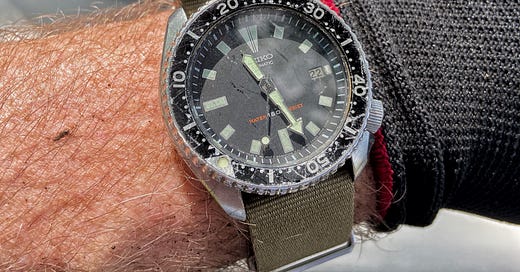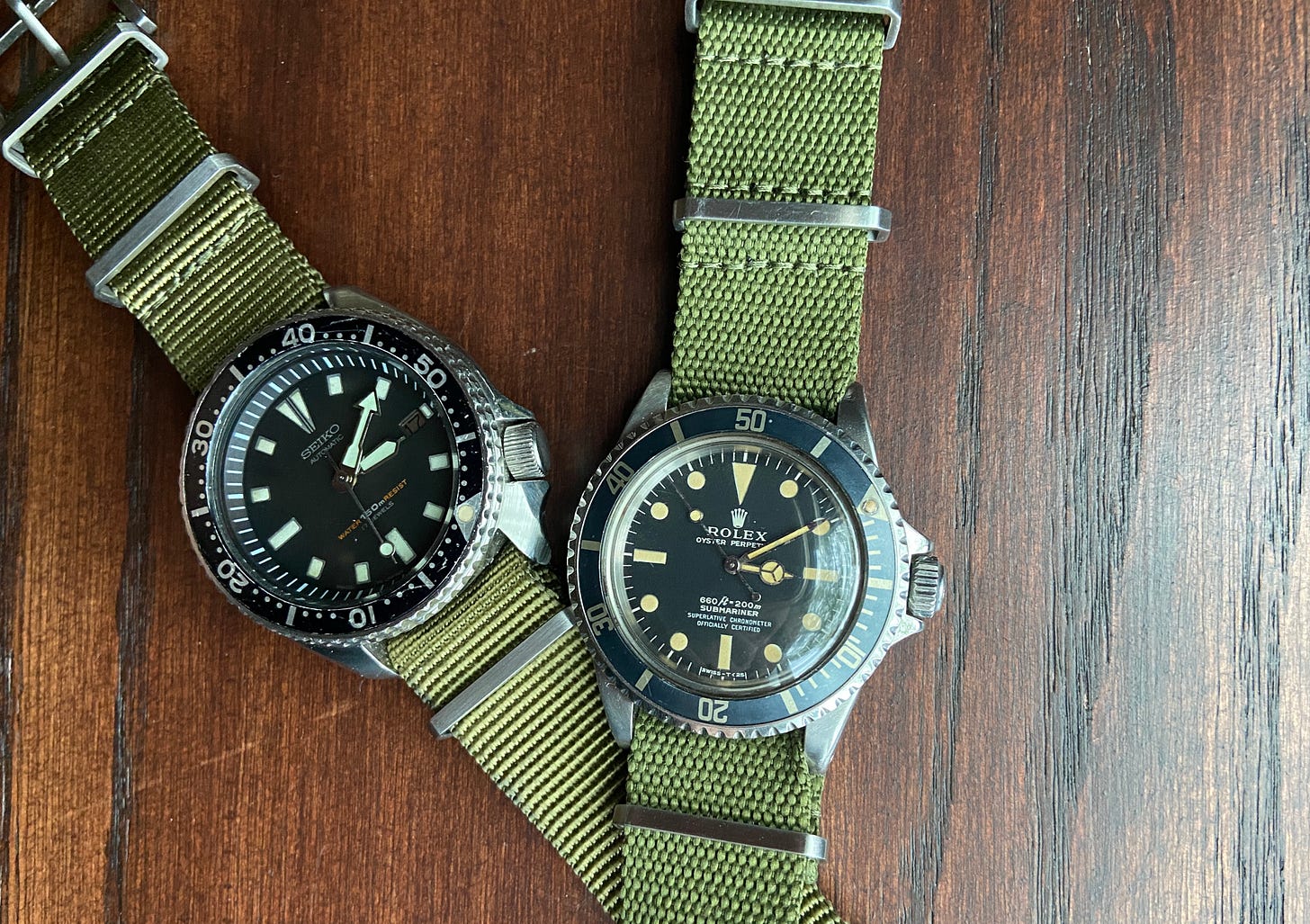On paper, and in hand, there isn’t a lot that separates a Rolex Submariner from a Seiko SKX. Both are steel dive watches, with rotating timing rings and water pressure ratings far deeper than that of any mortal scuba diver. Both are products of vertically integrated large companies, with movements designed and manufactured “in-house,” in a highly efficient and mechanized fashion. Both come from rich legacies of polar exploration, mountaineering exploits, and deep sea diving. Yet the former is valued at more than ten times the latter. To the uninitiated, and even to some of the initiated, this is a confusing discrepancy.
Back when I was a budding watch enthusiast, I wrote a post on a WatchUSeek forum, positing that a Seiko SKX007 was a better dive watch than an Omega Planet Ocean, two watches I had by then owned. I cited all of the above attributes and, while giving points to the Omega for keeping better time and being finished to a higher quality, I ultimately gave the edge to the Seiko due to the fact that, as a so-called “dive watch,” its lower price, ease of repair or replacement, and ubiquity make it more suited for actual use. Needless to say, I was thoroughly shelled for my thesis, called misinformed, ignorant, or worse. Looking for that thread now (it was around 2008), I think I must have ultimately deleted it, tail firmly between legs. But the idea has never left me. I touched on it a bit in a post here from last August, and again in March, but yesterday I strapped on a vintage Rolex after a few weeks with Seikos, and the question crops up again. What’s the difference, really?
Objectively speaking, my thesis is, if not true, at least in the ballpark. But watch collecting is anything but objective. I’m not trying to poke holes in collectors’ interests, or be an iconoclast by calling into question why certain watches are deemed more important/valuable or “better.” I’m trying to come to terms with my own collection and why I’m more comfortable wearing some more than others and maybe trying to level my horological playing field a bit.
Why don’t I wear my Rolex like I do a Seiko? Is it purely due to the monetary value of the former? Am I worried about breaking it or losing it and being out a lot more of my hard earned money? Shouldn’t the logic be that the more expensive watch should be the better built one, up to rigors of anything I could throw at a $300 watch? You pay more, you should expect more. These are questions from a guy who probably has worn more expensive watches in “risky” environments than most people. Yet, my Subs stay largely high and dry when rough duty calls, short of diving or an occasional hike. Yes, Rolexes are heirloom quality watches, but then a Seiko is just as easily passed down, and it’s a moot point anyway, since I actually have no heirs, nor plan to. So, assuming my watch collection isn’t going to a beloved son, or being saved as a nest egg or retirement plan, I’ll have them til I am pushing up daisies. I might as well wear them all for anything and everything. Every single one of them, from “Red Sub” to Pepsi Seiko.
What are we all saving our nicer watches for? If the value of a watch is what you do while wearing it, then the value should seemingly decline the less it is worn. Now I’m not a rich fat cat who would knowingly abuse something that’s worth a couple months’ salary. But if I’m out there advocating for “wear ‘em if you got ‘em,” shouldn’t I walk the talk? Of course, this is within reason, since sometimes (splitting wood, wrenching inside an engine) a watch is entirely inappropriate or downright dangerous to wear, Rolex, Seiko, or anything else. But then there a less tangible notion of personal comfort, and I don’t mean the way the watch sits on your wrist.
Growing up in the Midwestern US, Rolex, Omega, and most other Swiss brands were unfamiliar. That’s not to say they weren’t worn, but I can’t recall seeing any “nice” watches on other kids’ parents’ wrists, nor in our house. Priorities were different, a long tradition of modesty and frugality pervaded in the suburban Rust Belt, and, let’s face it, the ‘80s were not kind to the watch industry in general. It was appropriate then, that my first watch was a Seiko. Maybe that stuck with me. Despite years of owning and wearing, and writing about, countless high end European brands, they remain outside my comfort zone. It’s not that I’m embarrassed or ashamed to wear a Rolex, but something egalitarian and unassuming just feels more right on my wrist.
Going back to my original thesis, comparing a Seiko to a Rolex, if you take away prestige, resale, marketing, and the breathless poetic waxing of countless watch publications, there really isn’t much difference at all. I think I’ve always abhorred the idea of “precious” things. It’s a gut reaction, deep seated in my upbringing, perhaps even inherited. Assuming two watches are largely similar, if one is considered “better” due to some vague notion of prestige based on a logo on the dial, I immediately want to either thrash it, or simply wear the other. Call it reverse snobbery—a rejection of elitism and anything that smacks of luxury. Wearing a Rolex Submariner to cut the grass, build a fence, or fix a truck knocks it down to size, levels the playing field, and, ironically, is probably the most appropriate way to wear such a legendarily robust timepiece.
Yesterday, I pulled out a 1970 Rolex Submariner, ref. 5512 to wear. It had been well over a year since this watch was on my wrist, and when I look at it, I wonder why. It is as close to a perfect wristwatch as you can conjure. The no-date dial is symmetrical and eye pleasing, the faded markers and hands are turning a nice shade of butterscotch, the acrylic crystal has a high dome that you just don’t see on watches anymore, and the bezel is that a shade of blue-grey that has to be earned over 50 years in the elements. On a nylon NATO-style strap, it is light, comfortable, and unobtrusive. And it’s rugged. I’m not sure there’s anything I could do to this watch that it couldn’t survive. Sitting next to it on my desk now is a Seiko diver, ref. 7002 from the late ‘80s, also on a NATO strap, that has survived an awful lot. They look remarkably similar to the point of almost interchangeability. And you know what? I’m going to try to wear them interchangeably. No need to hide the Rolex away, safe from dings, scratches, and my own discomforts. Plant a shrub with it, change the oil with it, go kayaking with it. Just like a Seiko. It should hold up just as well. Or at least come close.






I've owned a Submariner and there's no doubt that is'a better made watch than the Seiko dive watches that I've owned, but the Seiko value is hard to resist. They are just so enjoyable to wear for so little money. I love that a lot of the models have their own identity (e.g. you can spot them from across the room, which is more than can be said for most others at their price point) and they feel durable, although admittedly not always very accurate. Also, there is a feeling of freedom by not having $10,000 strapped to your wrist when there's a good chance it could get damaged.
I currently have an SKX007 and just picked up a "Captain Willard" SPB183 (the blue 55th anniversary model) a few hours ago, so this article was timely.
Man, this is something I wrestle with a lot. I don't own any Rolexes, but my Bremont MBII is in a similar boat. I love it, and it's theoretically up for FAR more than anything I'll do to it. But when I go do something rough-and-tumble or will be around chemicals for work, I reach for my Scurfa Diver One or my Seiko SRP779.
But, I have an Aquastar on the way soon, and I think that I am probably going to take the route as you mentioned in this post- I think I am really just going to wear the hell out of it. It almost seems disingenuous to take something designed to be used in adverse conditions and not wear it in, well, adverse conditions. Even if it puts a few dings, and maybe needs a service sooner. It's tough to really make memories with a watch (or anything) if it's sitting at home. As the saying goes- "A ship in harbor is safe — but that is not what ships are built for."